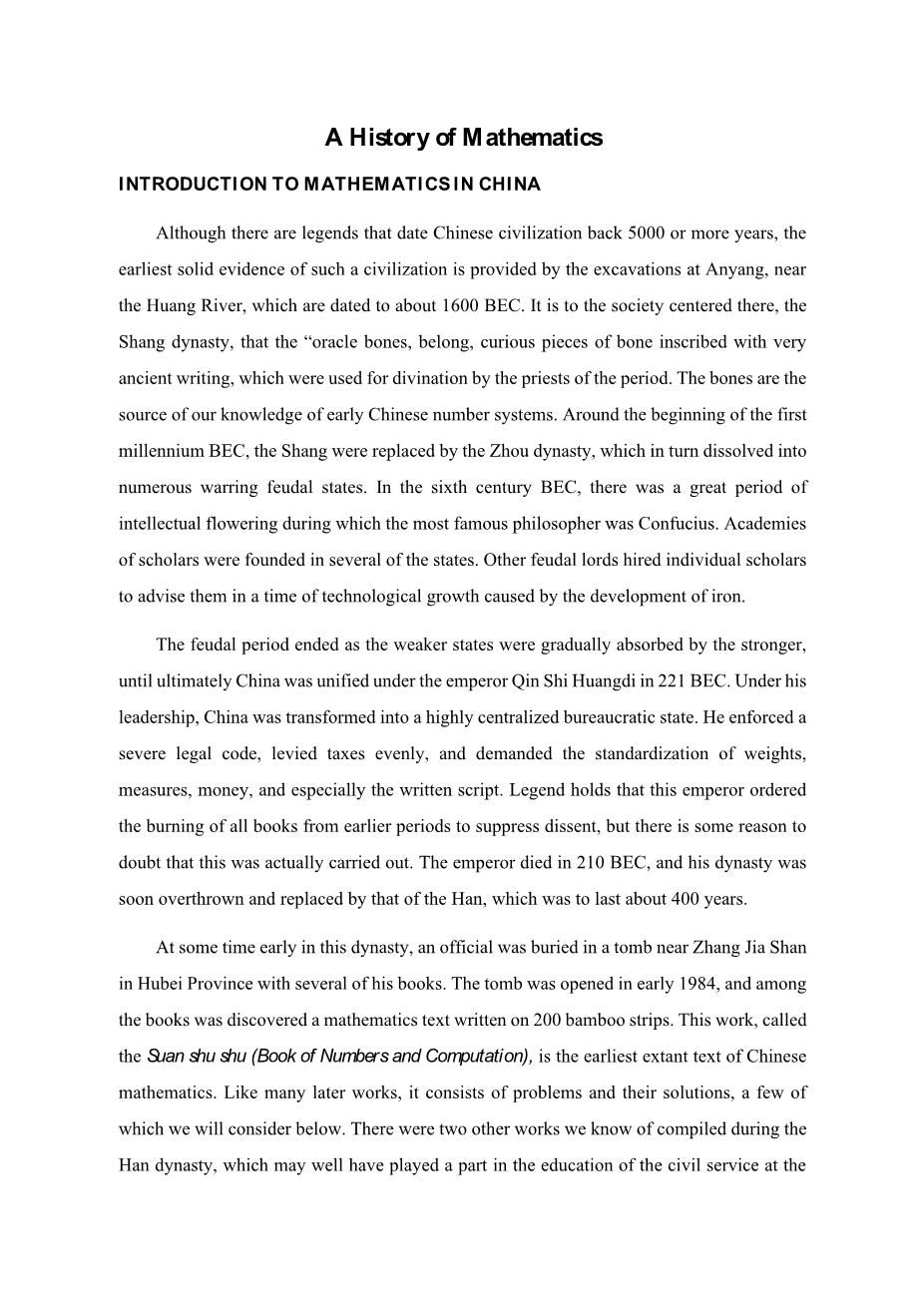

英语原文共 9 页,剩余内容已隐藏,支付完成后下载完整资料
原 文 著 作 :A History of Mathematics
作 者 :Victor J.Katz
原文出版单位:机械工业出版社
原文出版时间:2012年
原文部分:
INTRODUCTION TO MATHEMATICS IN CHINA
Although there are legends that date Chinese civilization back 5000 or more years, the earliest solid evidence of such a civilization is provided by the excavations at Anyang, near the Huang River, which are dated to about 1600 bce. It is to the society centered there, the Shang dynasty, that the “oracle bones,, belong, curious pieces of bone inscribed with very ancient writing, which were used for divination by the priests of the period. The bones are the source of our knowledge of early Chinese number systems. Around the beginning of the first millennium bce, the Shang were replaced by the Zhou dynasty, which in turn dissolved into numerous warring feudal states. In the sixth century bce, there was a great period of intellectual flowering during which the most famous philosopher was Confucius. Academies of scholars were founded in several of the states. Other feudal lords hired individual scholars to advise them in a time of technological growth caused by the development of iron.
The feudal period ended as the weaker states were gradually absorbed by the stronger, until ultimately China was unified under the emperor Qin Shi Huangdi in 221 bce. Under his leadership, China was transformed into a highly centralized bureaucratic state. He enforced a severe legal code, levied taxes evenly, and demanded the standardization of weights, measures, money, and especially the written script. Legend holds that this emperor ordered the burning of all books from earlier periods to suppress dissent, but there is some reason to doubt that this was actually carried out. The emperor died in 210 bce, and his dynasty was soon overthrown and replaced by that of the Han, which was to last about 400 years.
At some time early in this dynasty, an official was buried in a tomb near Zhangjiashan in Hubei Province with several of his books. The tomb was opened in early 1984, and among the books was discovered a mathematics text written on 200 bamboo strips. This work, called the Suan shu shu (Book of Numbers and Computation), is the earliest extant text of Chinese mathematics. Like many later works, it consists of problems and their solutions, a few of which we will consider below. There were two other works we know of compiled during the Han dynasty, which may well have played a part in the education of the civil service at the time. These are the Zhoubi suanjing (Arithmetical Classic of the Gnomon and the Circular Paths of Heaven) and the Jiuzhang suanshu (Nine Chapters on the Mathematical Art).
The Han dynasty in China disintegrated early in the third century ce, and China broke up into several warring kingdoms. The period of disunity lasted until 581, when the Sui dynasty was established, followed 37 years later by the Tang dynasty, which was to last nearly 300 years. Although another brief period of disunity followed, much of China was again united under the Song dynasty (960-1279), a dynasty itself overthrown by the Mongols under Ghenghis Khan. This dynasty was replaced by a native Chinese dynasty, the Ming, a hundred years later.
Despite the numerous wars and dynastic conflicts, a true Chinese culture was developing throughout most of east Asia, with a common language and common values. The system of imperial examinations for entrance into the civil service, instituted during the Han dynasty, lasted—with various short periods of disruption—into the twentieth century. Although the examination was chiefly based on Chinese literary classics, the demands of the empire for administrative services, including surveying, taxation, and calendar making, required that many civil servants be competent in certain areas of mathematics. Thus, in the Tang dynasty, as noted in the chapter opening, Li Chunfeng led the effort to collect and annotate what became known as the Ten Mathematical Classics. These included the Arithmetical Classic of the Gnomon, the Nine Chapters, Liu Hui*s Sea Island Mathematical Manual, the Mathematical Classic of Master Sun (fourth century ce), and the Mathematical Classic of Zhang Qiujuan (late fifth century ce), among others. An incomplete version of this set exists from the Song dynasty, printed in 1213, and a more complete version from the Ming dynasty, printed in 1403-1407. In general, these mathematical texts studied by candidates for the civil service were collections of problems with methods of solution. New methods were rarely introduced. The examination system often required recitation of relevant passages from the mathematics texts, as well as the solving of problems in the same manner as described in these texts. Thus, even though the Chinese imperial government encouraged the study of applicable mathematics, as indicated in the opening quotation, there was no particular incentive for mathematical creativity.
Nevertheless, creative mathematicians did appear in China, mathematicians who applied their talents not only to improving old methods of solution to practical problems but also to extending these methods far beyond the requirements of practical necessity. We look at developments in four major areas: numerical calculations, geometry, equation solving, and the solution of linear congruences. In particular, new discoveries in the
剩余内容已隐藏,支付完成后下载完整资料
资料编号:[406072],资料为PDF文档或Word文档,PDF文档可免费转换为Word


